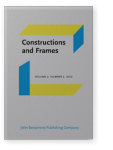Vol. 4:2 (2012) ► pp.186–230
Form deviation and constraints on productivity
A study of comp-gap and intervention effects in English and Swedish
Issues concerning the nature of so-called ‘filler-gap’ constructions and the constraints on their acceptability in different languages have for a long time been at the center of the linguistic debate. In more recent years, claims have often been made that many or all constraints on such constructions can be explained in terms of processing restrictions, properties of information structure, or limits to attention. However, in the present paper I will argue that at least some of these constraints cannot be explained by such factors. Instead, I will claim that speakers’ judgements of acceptability could be negatively affected if the syntactic structure of a productively formed instance of a schematic construction is not sufficiently similar to the prototypical entrenched structure of the same construction. Importantly, this might happen whether the relevant form is a phonological pattern, or a pattern of schematic syntactic categories. I will show how the proposed principles have the potential to explain a number of well-known constraints which have generally not been regarded as related. More specifically, I will show how the principles can account for some striking similarities between filler-gap constraints in English and Swedish, as well as some unexpected differences. I will also argue that the filler-gap constraint referred to as the complementizer-gap effect can be explained by the same principles that are involved in phenomena such as restrictions on wanna-contraction in English and adjective defectiveness in Swedish. The analysis will be based on the constructional approaches of Croft (2001) and Verhagen (2009), and some crucial issues will concern the relationship between syntactic and phonological structure in a construction, and the notions of non-iconic constituency and gradient syntactic attachment.
Cited by (2)
Cited by 2 other publications
This list is based on CrossRef data as of 1 july 2024. Please note that it may not be complete. Sources presented here have been supplied by the respective publishers. Any errors therein should be reported to them.
